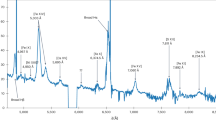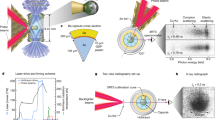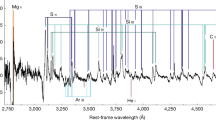Abstract
THE most probable explanation I know of the existence of cosmic clouds of calcium and sodium, which reveal themselves in the stationary lines H and K in the spectrum of many helium stars, wras proposed by Prof. Saha in NATURE of June 16, 1921, p. 488, on the ground of his theory of thermal ionisation. Ionised vapours of calcium, the resonance lines of which appear as H and K, are repelled by the radiation pressure of B-type stars, the radiation of which is particularly great in the region of those lines; in this way at a sufficient distance from the star there is an equilibrium between gravitation and selective radiation pressure, the conditions being specially favourable for Ca +, which forms extensive layers near the star.
This is a preview of subscription content, access via your institution
Access options
Subscribe to this journal
Receive 51 print issues and online access
$199.00 per year
only $3.90 per issue
Buy this article
- Purchase on SpringerLink
- Instant access to full article PDF
Prices may be subject to local taxes which are calculated during checkout
Similar content being viewed by others
References
"Zur Entdeckungsgeschichte der Malaria: eine historisch-entomologische Studie”, Zoologischer Anzeiger, vol. 58, 1924.
Author information
Authors and Affiliations
Rights and permissions
About this article
Cite this article
GERASIMOVI, B. Cosmic Clouds of Calcium and Sodium. Nature 113, 458–459 (1924). https://doi.org/10.1038/113458c0
Issue date:
DOI: https://doi.org/10.1038/113458c0



